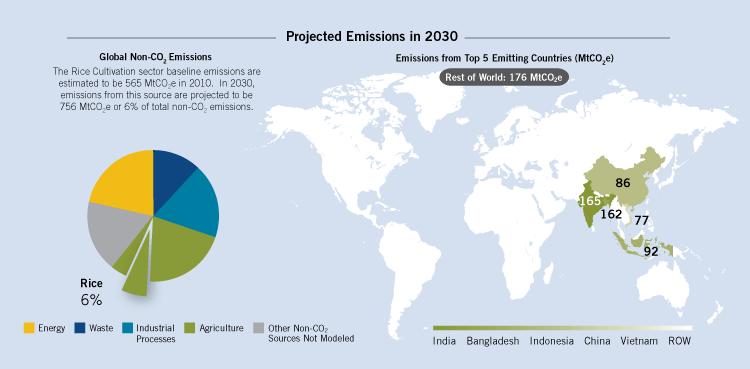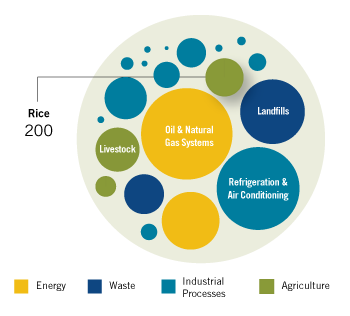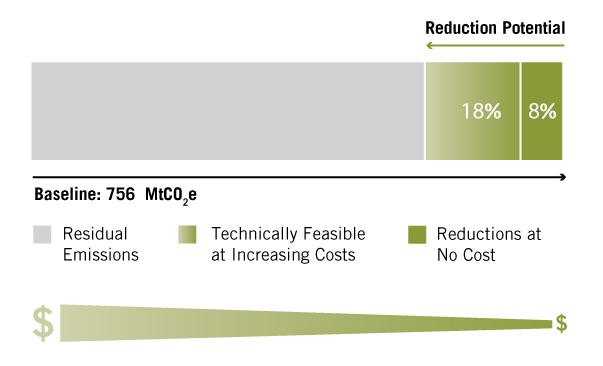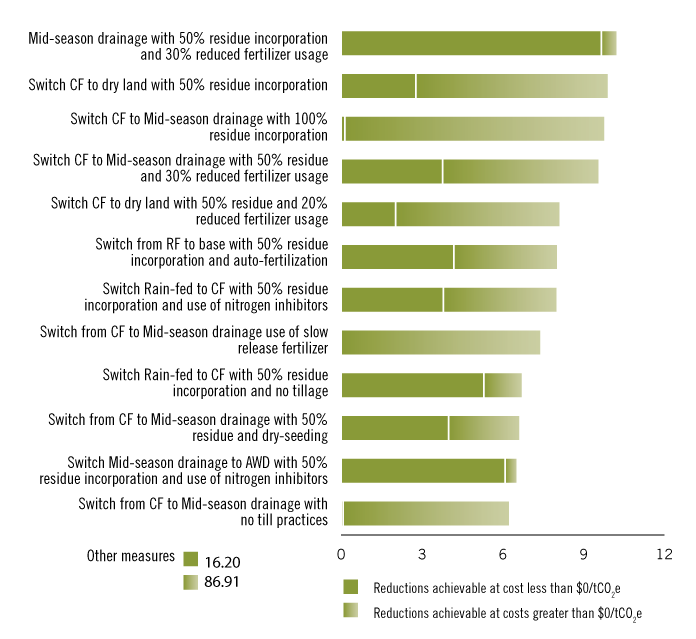Global Mitigation of Non-CO2 Greenhouse Gases: Rice Cultivation
Key Points
- The rice cultivation sector accounts for 6% of baseline non-CO2 emissions in 2030.
- Among five abatement measures evaluated, switching to dry-land production provides the largest emissions reductions.
- The technologically feasible reduction potential of the rice cultivation sector is 200 million metric tons of carbon dioxide equivalent (MtCO2e) in 2030, 26% of baseline sector emissions.
Sector Description
Rice cultivation is a source of methane (CH4) and nitrous oxide (N2O) emissions, and changes in soil organic carbon (C) stocks. When paddy fields are flooded, decomposition of organic material depletes the oxygen in the soil and floodwater, causing anaerobic conditions. Human activities influence soil N2O emissions (use of fertilizers and other crop management practices) and soil C stocks (residue and crop yield management). Global baseline emissions from the rice cultivation sector were estimated to grow from 565 to 756 MtCO2e from 2010 to 2030.
 View or download the full-size image here.(123 K, PNG)
View or download the full-size image here.(123 K, PNG)
Emissions Reduction Potential
Assuming full implementation of current technology, emissions in the rice sector could be reduced by up to 200 MtCO2e in 2030. This accounts for 4% of the 4,615 MtCO2e in global reduction potential in 2030.
 View or download the full-size image here.(102 K, PNG)
View or download the full-size image here.(102 K, PNG)
Abatement Potential
Technologically feasible global abatement potential for the rice cultivation sector was estimated at 203 MtCO2e in 2020 and 200 MtCO2e in 2030, 28% and 26% reductions compared to the baseline. In 2030, a reduction of 58 MtCO2e would be possible at an abatement cost of $0/tCO2e and 135 MtCO2e would be possible at a cost of $30/tCO2e.
 It would be cost-effective to reduce emissions by 3%, compared to the baseline, in 2030. An additional 7% reduction is available using technologies with increasingly higher costs.
It would be cost-effective to reduce emissions by 3%, compared to the baseline, in 2030. An additional 7% reduction is available using technologies with increasingly higher costs.
View or download the full-size image here.(37 K, PNG)
Abatement Measures
Five types of abatement measures were considered: paddy flooding (continuous, mid-season, alternating, dry), crop residue incorporation (50% and 100%), tillage (conventional and no till), fertilization application (conventional, ammonium sulfate, nitrification inhibitor, slow-release, reduced use, auto fertilization), and direct seeding. Switching to dry-land production provides the largest emissions reductions, though it results in major reductions in rice yield.
 Emissions reductions by technology in 2030 at $0/tCO2e and at higher prices.
Emissions reductions by technology in 2030 at $0/tCO2e and at higher prices.
View or download the full-size image here.(72 K, PNG)
